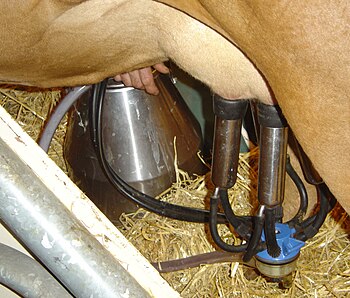Dreamy Jazz (talk | contribs) m Replace with dedicated template using AWB |
Pbsouthwood (talk | contribs) mNo edit summary |
||
| Line 1: | Line 1: | ||
{{Portal maintenance status|date=June 2018}}{{Portal description}}<!-- This portal was created using subst:box portal skeleton| topic=Topic| --> |
{{Portal maintenance status|date=June 2018}} |
||
{{Portal description}} |
|||
<!-- This portal was created using subst:box portal skeleton| topic=Topic| --> |
|||
{{Portals browsebar}} |
{{Portals browsebar}} |
||
{| width="100%" cellpadding="5" cellspacing="10" style="background:#99FF66; border-style:solid; border-width:1px; border-color:#;#99FF66" |
{| width="100%" cellpadding="5" cellspacing="10" style="background:#99FF66; border-style:solid; border-width:1px; border-color:#;#99FF66" |
||
Revision as of 10:37, 11 July 2018
Agriculture and agronomy portal Agriculture encompasses crop and livestock production, aquaculture, fisheries, and forestry for food and non-food products. Agriculture was the key development in the rise of sedentary human civilization, whereby farming of domesticated species created food surpluses that enabled people to live in cities. While humans started gathering grains at least 105,000 years ago, nascent farmers only began planting them around 11,500 years ago. Sheep, goats, pigs, and cattle were domesticated around 10,000 years ago. Plants were independently cultivated in at least 11 regions of the world. In the 20th century, industrial agriculture based on large-scale monocultures came to dominate agricultural output. , small farms produce about one-third of the world's food, but large farms are prevalent. The largest 1% of farms in the world are greater than 50 hectares (120 acres) and operate more than 70% of the world's farmland. Nearly 40% of agricultural land is found on farms larger than 1,000 hectares (2,500 acres). However, five of every six farms in the world consist of fewer than 2 hectares (4.9 acres), and take up only around 12% of all agricultural land. Farms and farming greatly influence rural economics and greatly shape rural society, effecting both the direct agricultural workforce and broader businesses that support the farms and farming populations. The major agricultural products can be broadly grouped into foods, fibers, fuels, and raw materials (such as rubber). Food classes include cereals (grains), vegetables, fruits, cooking oils, meat, milk, eggs, and fungi. Global agricultural production amounts to approximately 11 billion tonnes of food, 32 million tonnes of natural fibres and 4 billion m3 of wood. However, around 14% of the world's food is lost from production before reaching the retail level. (Full article...) Selected articleCattle (colloquially cows) are the most common type of large domesticated ungulates. They are a prominent modern member of the subfamily Bovinae, are the most widespread species of the genus Bos, and are most commonly classified collectively as Bos primigenius. Cattle are raised as livestock for meat (beef and veal), as dairy animals for milk and other dairy products, and as draft animals (oxen / bullocks) (pulling carts, plows and the like). Other products include leather and dung for manure or fuel. In some countries, such as India, cattle are sacred. It is estimated that there are 1.3 billion cattle in the world today. In 2009, cattle became the first livestock animal to have its genome mapped. Cattle are farmed for beef, veal, dairy, leather and they are less commonly used for conservation grazing, simply to maintain grassland for wildlife – for example, in Epping Forest, England. They are often used in some of the most wild places for livestock. Depending on the breed, cattle can survive on hill grazing, heaths, marshes, moors and semi-desert. Modern cows are more commercial than older breeds and, having become more specialized, are less versatile. For this reason many smaller farmers still favor old breeds, like the dairy breed of cattle Jersey. (Full article...) Selected picture Credit: David.Monniaux A cow milking machine in action. This photo was taken on March 7, 2003
at the Salon de l'agriculture (Salon of agriculture) in Paris, France. Sustainable agricultureDid you know...Agriculture and agronomy journals
See also: WikiProjectsTopicsThings you can do
Related portalsCategoriesRelated articlesAssociated WikimediaThe following Wikimedia Foundation sister projects provide more on this subject:
|
- ^ Aborigines may have farmed eels, built huts ABC Science News, 13 March 2003.
- ^ Lake Condah Sustainability Project. Retrieved 18 February 2010.










